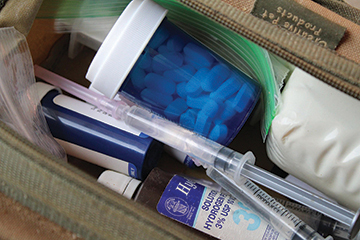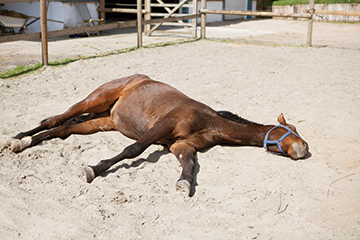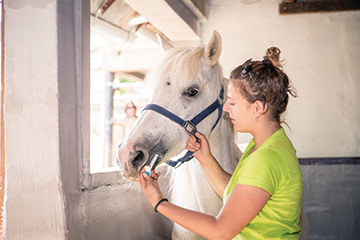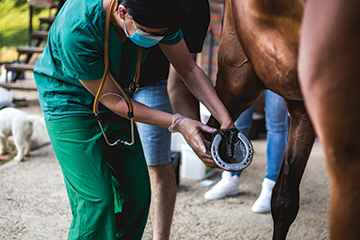
Smart Use Of Non-Steroidal Anti-Inflammatory Drugs
 By Nancy S. Loving, DVM
By Nancy S. Loving, DVM
Medications that relieve pain are commonly used for equine athletes to address musculoskeletal issues. Such anti-inflammatory drugs do just that – reduce inflammation and mitigate pain. The most commonly used medications are called non-steroidal anti-inflammatory drugs, or NSAIDs. These drugs are also the ones used to help reduce discomfort in a horse that is experiencing gastrointestinal upset, like colic. But there are some things you might want to know about casual use of NSAIDs, particularly in the face of gastrointestinal upset.
What Do NSAIDs Do?
The usual suspects, phenylbutazone (aka “bute”), flunixin (Banamine), or ketoprofen, are considered COX (cyclo-oxygenase) inhibitors that act as anti-inflammatory agents. These examples are non-specific NSAIDs, so called because there is more than one form of COX – COX-1 and COX-2. These medications block both arms of the COX inflammatory cycle to disrupt the pathways leading to all prostaglandin synthesis in the body. Prostaglandins normally make nerves, including those innervating the GI tract, sensitive to pain – NSAIDs block prostaglandin production. While NSAID administration works great for controlling pain, inflammation, or fever, it also interferes with normal, daily protective functions of many organs. The result is the potential for significant, unwanted side effects.
“Good” protective prostaglandins in the body are responsible for maintenance of normal blood flow and nutrition to the intestinal lining and deep portions of the kidneys. Blocking these prostaglandins by non-specific NSAIDs affects blood flow to these areas with the potential to develop gastric ulcers, colonic ulcers, and necrosis of kidney tubules. Horses are already predisposed to kidney and GI injury during a colic episode; adding an NSAID exacerbates this risk.

The Safest Approach to Colic
In the face of a colic crisis, first gather information about the three P’s of colic: Pulse, Pain, and Peristalsis (audible intestinal activity) along with mucous membrane color and refill time. Convey this information as you consult with your veterinarian to determine if the horse needs to be examined promptly and what to do in the meantime. Your vet can provide helpful recommendations based on experience and medical training.
Owner-administered NSAID treatment in the face of colic is a concern. Out in the field (or at the barn), NSAIDs tend to mask clinical signs and the severity of a colic that needs more aggressive intervention. An owner or trainer who feels compelled to “do something,” might instead walk the horse for a short bit or place him in a well-bedded stall for monitoring. Vibrations from a trailer ride, especially on gravel roads, may also provide some therapeutic value, particularly for gas colic.
It is important to avoid delay in evaluation and veterinarian treatment of a progressive and serious colic. When an owner or trainer recognizes that a horse is having a problem, rather than just giving a dose of NSAID and waiting, it is best to contact the vet immediately to relay information about the horse’s vital signs and behavior. This rapid contact to obtain your veterinarian’s recommendations may save a horse’s life.
Short-term colic survival is 80-85%, particularly when horses are treated in the early stages. Even a large colon volvulus (twist) that is admitted quickly to surgery can achieve a similar survival rate. The goal is to reduce the duration of colic – this is best achieved through rapid veterinarian assessment and diagnosis, and rapid medical intervention with diligent monitoring.
The Downsides of NSAID Administration for Colic
As it turns out, on average, the referral time from the onset of a colic crisis to the horse being admitted for aggressive treatment is 12-18 hours. During this delay, a horse becomes progressively sicker – not only does this escalate treatment costs, but it also lessens the chances of successful resolution with or without surgery.
An owner (or trainer) might ask themselves this question: Would you consider taking the horse to a referral hospital for advanced diagnostics and/or surgery? If yes, then consider the cost and if the horse is insured, or not. It’s always best to err on the safe side to keep options open – have a veterinarian attend quickly to the horse to determine if it’s appropriate to haul into a referral hospital when the horse can’t be managed appropriately in the field.
Giving a “full dose” (10 cc or 1000 micrograms (mcg)) of flunixin to a colicky horse without a veterinarian’s evaluation potentially delays appropriate treatment and worsens the prognosis. For example, pain of a simple impaction may respond well to this amount of flunixin, yet this does nothing to treat the primary problem – with time and without fluid therapy, an impaction often worsens. A once simple, easily remedied problem may now result in the need for colic surgery.
On an annual basis, 10% of horses experience colic. Of these, 10% need surgery. When pain-relieving medication is ineffective and/or pain returns, this puts the horse into a risk category for more extensive treatment or surgery. Even if surgical intervention isn’t an option for an owner, medical care and IV fluids are very important, particularly for impactions or mild intestinal displacements.
Some conditions, such as cecal impactions, initially develop relatively mild colic signs, but may prove fatal if NSAIDs are administered without additional treatment. Toxicity of NSAIDs may result in kidney failure and development of gastrointestinal ulcers if the horse is given a “full dose” without proper assessment of hydration status. If it is necessary to administer flunixin prior to veterinary assessment, then only give a half dose (5 cc or 500 mcg), or better yet, give only 1/4 dose (2-1/2 cc or 250 mcg). This alleviates pain without masking more serious conditions that require additional treatment. Or consider using a sedative or other pain-relieving medication discussed below.
Oral versus Injectable NSAID 
Treatment with any oral drug formulation takes longer to take effect than the intravenous version. While duration until onset varies between individual horses, oral flunixin may take 1-2 hours to achieve pain-relieving effects compared to more immediate effects (10-15 minutes) with intravenous formulations. Bioavailability is slower and blood levels lower following oral administration. Once an oral dose has been given, particularly a “full 1000 mcg dose,” then no more injectable NSAID can be added – this hampers the rapid IV treatment a veterinarian can provide when attending the horse.
The slow onset of action makes oral NSAIDs far from optimal for treating acute colic – clinical signs continue for a period of time before drug effects kick in. If gastrointestinal motility is reduced, as is common with an intestinal crisis, there is likely to be a corresponding slowed effect on oral drug absorption and metabolism. Orally-administered NSAIDs normally have a prolonged half-life (4.5 – 10 hours) compared with an IV counterpart (1.5 - 4 hours). An oral NSAID could allow a condition to go undiagnosed and untreated, thereby prolonging both treatment and cost.
Although flunixin is labeled for either IV or IM use, flunixin should never be administered intramuscularly (IM). Adverse muscle effects can occur with muscle injection of many drugs, ranging from mild swelling, heat and pain that is resolved with hot packing and topical DMSO. But, in rare cases, intramuscular flunixin is associated with a rapidly progressive, life-threatening muscle infection – Clostridial myositis. Clostridial spores are carried by the needle inward from the skin surface. Coupled with tissue damage from the highly irritating nature of flunixin, full-blown myositis can develop. These horses become extremely toxic and are very difficult to save. IM flunixin administration is simply not worth the risk, no matter how small the dose. The IV form of flunixin can be administered orally if intravenous access is a problem.
Phenylbutazone, an intravenous preparation, should also never be given intramuscularly because it is extremely caustic to muscle.
Alternatives to NSAIDs for Colic
Besides NSAIDs, there are a variety of pain-managing medications, such as a short-acting analgesic like xylazine or butorphanol – these achieve pain relief for about 40 minutes. If the horse is fine after such medication wears off, then flunixin (at half or one-quarter dose) could then be given. However, if pain persists, the horse’s situation needs further veterinary investigation.
Short-acting analgesic agents have few adverse effects while effectively blocking pain. For simple gas colic, interrupting
pain often allows sufficient intestinal muscle relaxation to allow gas to move through the bowel and evacuate. These analgesic agents also reduce intestinal motility for a short time and that helps mitigate painful GI spasms.
Use of longer-acting analgesics such as detomidine (Dormosedan) is recommended in cases where pain is uncontrollable, and the horse is at risk of injuring itself. Detomidine is also useful for transport to a surgical facility in cases of very severe colic. An oral formulation of Dormosedan gel can be safely applied to the horse’s gums for rapid absorption.
A common indication for the need for surgery is when repeated drug administration is required to control pain. Repeated dosing is not recommended and can result in dehydration from diuretic effects.
Check with your equine insurance agent as in some cases, insurance coverage is denied if there is an adverse event subsequent to owner administration of an injectable sedative or analgesic.
 NSAIDs for Musculoskeletal Concerns
NSAIDs for Musculoskeletal Concerns
Horses with lameness problems are often managed for weeks or even months with anti-inflammatory doses of NSAIDs. But this is not without its pitfalls. Right dorsal colitis (RDC) is a serious condition that may result from chronic administration of NSAIDs. Ulcers in the right dorsal colon lead to protein loss, colic, and permanent colon strictures. How long it takes to develop RDC is highly variable between horses – for sensitive individuals, it may develop within a few weeks after the onset of NSAID treatment. Higher doses may contribute to greater colon injury. That said, many horses have been known to survive for years on low-dose NSAID treatment with no apparent problems.
Gastric ulcers are also known to develop from chronic NSAID use, especially when coupled with stress and high performance. Stomach erosions can occur quickly, within days. While ulcers in the glandular stomach area don’t usually affect performance, gastric ulcers can elicit episodes of colic – treating such a horse with NSAIDs is counterproductive and ill-advised.
In studies comparing phenylbutazone and flunixin for musculoskeletal pain, the two drugs appear comparable when administered at label dosages. Giving more phenylbutazone or giving both phenylbutazone and flunixin together for musculoskeletal pain provides no added analgesic benefit and is likely harmful to the kidneys and GI tract.
The advent of COX-2 specific NSAIDs, such as firocoxib (Equioxx®), has increased safety margins for long-term administration of NSAIDs. Still, adverse effects can develop over time or for sensitive individuals.
Caution should always be exercised by an owner who is inclined to treat a lameness concern with an NSAIDs without a veterinary exam. Excessive use of NSAIDs can mask pain from injuries and potentially result in fatal consequences, especially in racehorses. For example, a non-displaced limb fracture or stress fracture may progress to a life-threatening, complete fracture if NSAID-blockage of pain allows a horse to overuse the injured limb.
Another common yet highly inappropriate practice is for a horse owner to hand off their NSAID medication to another with suggestions on how to use it despite lacking a veterinary diagnosis or counsel. It is reported that 82% of horse owners use NSAIDs without advice from their veterinarian.
